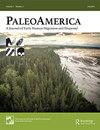从俄勒冈州康利第 5 洞穴的土壤微形态推断小旱期的霜冻作用
IF 1.7
Q1 ANTHROPOLOGY
引用次数: 0
摘要
ABSTRACT The Younger Dryas chronozone is an abrupt climate event terminating the last glacial period ∼12,900-11,700 calendar years ago marked by rapid changes in regional human, floral, and faunal population dynamics across the globe.我们在俄勒冈州石堡盆地的 Connley 5 号洞穴工作,证明了这一寒冷事件产生的微观低温特征(霜冻作用)可用于确定大盆地北部是否存在小干世,揭示古环境条件,并向考古学家介绍晚更新世向全新世早期过渡时期的遗址形成过程。这些数据让我们了解了康尼利石窟的低温扰动,并对保存在整个大盆地的年轻旱期考古遗址产生了影响。本文章由计算机程序翻译,如有差异,请以英文原文为准。
Frost Action during the Younger Dryas Inferred from Soil Micromorphology at Connley Cave 5, Oregon
ABSTRACT The Younger Dryas chronozone is an abrupt climate event terminating the last glacial period ∼12,900–11,700 calendar years ago marked by rapid changes in regional human, floral, and faunal population dynamics across the globe. Working at Connley Cave 5 in the Fort Rock Basin, Oregon, we demonstrate that this cold event generated microscopic cryogenic features (frost action) which can be used to identify the presence of the Younger Dryas in the northern Great Basin, shed light on paleoenvironmental conditions, and inform archaeologists about site formation processes occurring across the Late Pleistocene to Early Holocene transition. These data inform us about cryoturbation at Connley Caves and have implications for Younger Dryas-aged archaeological sites preserved throughout the Great Basin.
求助全文
通过发布文献求助,成功后即可免费获取论文全文。
去求助
来源期刊

PaleoAmerica
Earth and Planetary Sciences-Paleontology
CiteScore
3.70
自引率
0.00%
发文量
15
期刊介绍:
PaleoAmerica disseminates new research results and ideas about early human dispersal and migrations, with a particular focus on the Americas. It fosters an interdisciplinary dialog between archaeologists, geneticists and other scientists investigating the dispersal of modern humans during the late Pleistocene. The journal has three goals: First and foremost, the journal is a vehicle for the presentation of new research results. Second, it includes editorials on special topics written by leaders in the field. Third, the journal solicits essays covering current debates in the field, the state of research in relevant disciplines, and summaries of new research findings in a particular region, for example Beringia, the Eastern Seaboard or the Southern Cone of South America. Although the journal’s focus is the peopling of the Americas, editorials and research essays also highlight the investigation of early human colonization of empty lands in other areas of the world. As techniques are developing so rapidly, work in other regions can be very relevant to the Americas, so the journal will publish research relating to other regions which has relevance to research on the Americas.
 求助内容:
求助内容: 应助结果提醒方式:
应助结果提醒方式:


